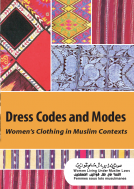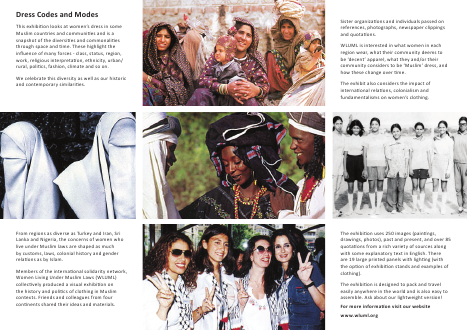WLUML Exhibition: Dress Codes & Modes

The exhibition looks at women's dress in some Muslim countries and communities and is a snapshot of diversities and commonalities through space and time. These highlight the influence of many forces – class, status, region, work, religious interpretation, ethnicity, urban/rural, politics, fashion, climate.
We celebrate this diversity as well as our historic and contemporary similarities. Comprised of 20 large printed panels focusing on women's clothing in Muslim contexts generally, and then in 7 specific countries and regions: Turkey, Iran, Egypt, Northern Nigeria, South Asia, Pakistan and Sri Lanka, the exhibition uses 250 images (paintings, drawings, photos), past and present, and over 85 quotations from a rich variety of sources plus some explanatory original text.
The exhibition is designed to pack and travel easily anywhere in the world for display at events and conferences and is also easy to assemble. Ask about our lightweight version! For more information visit our website: www.wluml.org or email us on WLUML
Further highlights from some of the exhibition panels are available in Flash below.
Diversity and commonality through space and time
We briefly look at men's dress and at clothes worn by women from communities other than Muslim, in order to show continuity beyond gender and community/religious divides. We see variety and uniformity across space and time, which highlight the influence of the many forces which create dress - politics, class, status, region, work, religious interpretation, ethnicity, urban/rural divides, fashion, climate. We also see how people change or modify dress to suit new and different situations and places.
Identity, morality and autonomy
Recording the changes in dress that have and continue to take place within various Muslim contexts has a political meaning.
"The different parts of the structure (of costume) are consciously manipulated to assert and demarcate differences in status, identity and commitment (support or protest) at the level of personal, national and international relationships." (Costume and identity, Hilda Kuper, 1973)
In the current context, the spread of supposed 'Islamic' dress for women and enforcement of such dress codes through law and/or the threats and actions of self-appointed male 'guardians of morality' is well-documented. Indeed morality and the control of autonomy is at the core of norms and values that influence dress codes - as this Egyptian male advocate of women's rights highlights as early as 1899:
"Are men considered less able than women to control themselves and resist their sexual impulse? … Preventing women from showing themselves unveiled expresses men's fears of losing control over their minds, falling prey to fitna [chaos] whenever they are confronted with a non-veiled woman. The implications of such an institution lead us to think that women are believed to be better equipped in this respect than men." (The Liberation of Women, Qasim Amin, 1899)
International agendas and individual agencies
However, lesser known is the fact that particular styles of 'Islamic' dress being imposed and adopted often have no basis in the tradition of the country and are being imported from other Muslim contexts to further specific political ends. For example in Sudan (after the coup led by the National Islamic Front in 1989), the "Islamic Dress Law" effectively banned the traditional Sudanese women's dress ("Toab") in favour of 'Islamic' dress. The Sudanese state successfully imposed this new outfit onto women civil servants by prohibiting any woman dressed otherwise from entering government offices. The new dress code was identical to the Iranian 'model' and, in fact, Iran financed the mass production of these uniforms.
It is precisely the invocation of "tradition" and "indigenous values" which blurs the fact that practices and legislations supposed to be "Islamic" are in fact carefully crafted to fit the agenda of conservative Muslim forces.
Where women do endorse particular 'Muslim' dress codes as a marker of identity and consciously choose to adopt specific styles of dress in order to assert their own identity - religious or otherwise - this is invariably based on a homogenous model of 'Muslimness'. Whether this reinforces conservative discourse or enables women to recapture the discourse around Muslim women's role continues to be a subject of debate.
The exhibition is designed for display at events and conferences. There are 19 large printed panels with lighting (with the option of exhibition stands and examples of clothing). It travels in 9 sturdy cases. These boxes weigh a total of 215kg. Normally, the exhibitor will be responsible for travel costs and insurance. There is no fee for renting the exhibit, but there is a modest admin charge.
| Attachment | Size |
|---|---|
| Indroduction.swf | 1.21 MB |
| Egypt.swf | 1.5 MB |
| Iran.swf | 833.1 KB |
| Northern Nigeria.swf | 619.13 KB |
| Pakistan.swf | 1.14 MB |
| Turkey.swf | 1.05 MB |
| Acknowledgement.swf | 108.67 KB |

Related News
- Yemen war survivor struggles to provide education to women
- Harvard Women’s Law Association honours Shadi Sadr for contributions to human rights, women & LGBT rights in Iran
- Leading human rights lawyer Asma Jahangir passes away in Lahore
- Iran protests latest: Pictures showing Tehran woman removing hijab during anti-government rally hailed as symbol of defiance
- The Prosecutor of the International Criminal Court, Fatou Bensouda, requests judicial authorisation to commence an investigation into the Situation in the Islamic Republic of Afghanistan
Related Actions
- On May 28, International Day of Action for Women’s Health, Women’s Rights Defenders Mobilize Worldwide Calling for the Inclusion of Women’s Sexual and Reproductive Health and Rights in the Post-2015 Development Agenda
- Universality Of Human Rights At Stake! Act Now To Oppose Russian Resolution On Traditional Values!
- VNC Statement: The Vatican's Crackdown Against the Nuns Is Unacceptable and Deplorable
- International: Statement of Feminist and Women's Organisations on the very Limited and Concerning Results of the 56th Session of the UN Commission on the Status of Women
- International: Open letter to President of the Human Rights Council regarding sexual orientation and gender identity
Relevant Resources
- Chic Resistance - Women, Fashion, and Politics in Iran
- Thematic report on article 16, Muslim Family Law and Muslim Women's Rights in Singapore
- Women's Sport as Politics in Muslim Contexts
- WLUML Gazette, 14th Edition at the end of 2014
- Influences of Religious Fundamentalism on Sexual and Reproductive Health and Rights of Women
